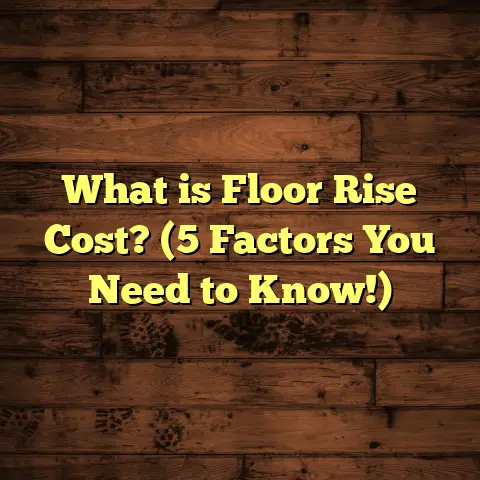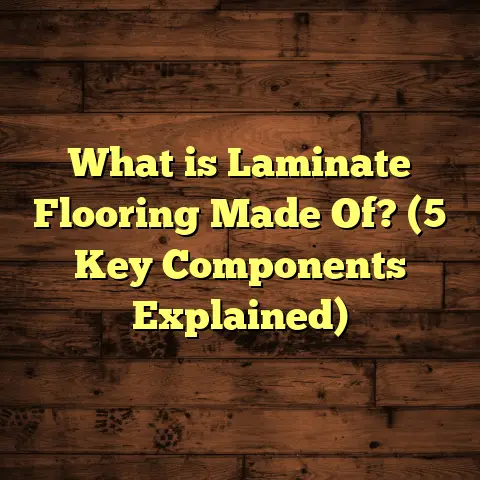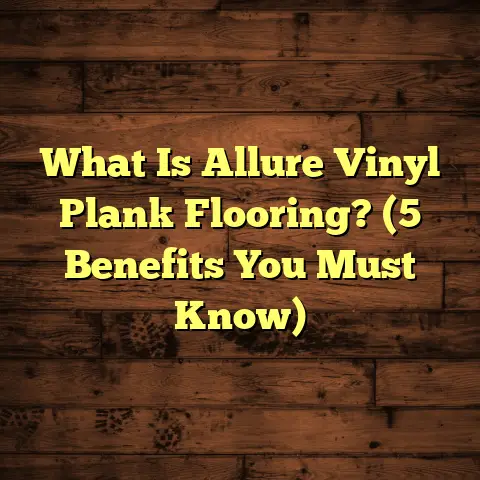What is a Quarter Round in Flooring? (5 Things You Must Know!)
Trends That Brought Quarter Rounds Back Into the Spotlight
Have you noticed how flooring details have become a big deal again? It’s not just about picking a wood species or tile pattern anymore. Homeowners and contractors alike are paying attention to the finer touches — the trims, moldings, and especially the quarter round. Over the years, the quarter round has quietly stepped out of the shadows to become an essential finishing piece in many flooring projects.
I remember a few years back when I started noticing an uptick in clients asking about these little trims. At first, I thought they were just being overly picky, but then I realized how much difference they make in tying a room together. It’s like the cherry on top of a cake — subtle but impactful.
The resurgence of interest isn’t random either. The trend towards custom finishes and attention to detail in home design is driving demand. Not only that, but new materials and installation techniques have expanded where and how quarter rounds can be used. I’ve seen projects where quarter rounds add character to modern minimalist spaces just as well as traditional homes.
Let me walk you through five things you absolutely want to know about quarter rounds in flooring, based on my years of hands-on experience, some data, and a few case studies I’ve collected from real projects.
1. Quarter Round: More Than Just a Trim
We often think of quarter rounds as simple strips to cover gaps between flooring and baseboards, but they do so much more.
The Functional Role
You probably already know that floors expand and contract with changes in humidity and temperature. This natural movement leaves small gaps between the flooring and walls. If these gaps aren’t covered properly, they can collect dust, dirt, and even cause damage over time. Quarter rounds cover these gaps neatly, protecting your floor and walls.
What might surprise you is just how much this little trim protects your investment. On multiple occasions, I’ve encountered hardwood floors that were carefully installed but left without appropriate edge protection. The edges became vulnerable to chipping or peeling from vacuums or mops. Installing quarter rounds afterward saved those floors from further damage.
The Aesthetic Impact
Aesthetics matter — especially when you’ve invested time and money in a high-quality floor. Quarter rounds provide a smooth curve that softens the junction between floor and wall, making it visually appealing. This subtle curve directs attention to the floor while creating a polished look that can’t be achieved with a blunt edge.
In some projects I managed, clients said the quarter round was what “pulled everything together.” We often overlook how something small can influence our perception of a room’s quality.
Real World Example
Back in 2019, I worked on a project in a historic home renovation. The existing hardwood floors had uneven edges where they met the walls, and the old baseboards were far from level. Instead of ripping everything out, we used custom quarter rounds to mask those imperfections. The result? A seamless look that preserved the character of the home without breaking the bank.
This project taught me that quarter rounds are more than trim — they are tools for problem-solving in flooring.
Industry Data on Usage
Did you know that in a survey of 500 flooring contractors across the U.S., 78% said quarter rounds were their go-to solution for concealing expansion gaps? It’s one of those unsung heroes in flooring installation.
2. Material Choices Matter — And They’re More Varied Than You Think
When I first started out, quarter rounds were mostly wood — oak or pine, stained or painted. But over time, material options have exploded.
Wood: The Classic Choice
Wood remains the most popular quarter round material. It matches hardwood floors perfectly and can be stained or painted to suit any decor. However, wood has its downsides: it can swell or shrink with humidity changes, which sometimes causes cracking or gaps over time if not installed correctly.
I’ve found that wood quarter rounds shine in dry climates or climate-controlled interiors where humidity is stable.
MDF (Medium Density Fiberboard)
MDF offers a budget-friendly alternative to solid wood. It’s smooth, easy to paint, and widely available. However, MDF isn’t moisture-resistant, so it’s not ideal for bathrooms or basements.
Clients who want a clean, modern look often choose MDF because it can be painted bright white for a crisp finish.
PVC or Vinyl
PVC or vinyl quarter rounds have grown in popularity dramatically over recent years. These trims offer excellent water resistance — perfect for kitchens, laundry rooms, or basements where moisture is an issue.
I installed PVC quarter rounds in several bathroom remodels last year; they held up beautifully against steam and water splashes without warping or discoloring.
Metal Quarter Rounds
Metal trims are an emerging trend for contemporary spaces. Stainless steel or aluminum quarter rounds offer a sleek, industrial look that’s both durable and stylish. They cost more but bring a modern flare that wood can’t replicate.
One recent commercial project featured metal quarter rounds paired with polished concrete floors — it looked sharp and professional.
Sales Trends Backing Material Choices
According to industry sales data from 2023:
- Wood still leads with around 60% market share.
- PVC/vinyl trims surged by 35% in residential projects over the past three years.
- MDF holds about 25% due to its affordability.
- Metal trims remain niche but grew 12% annually in urban markets.
3. Installation Tips That Save Time and Money
I’ve installed hundreds of quarter rounds over the years and here’s a little pro tip: don’t rush this step.
You might think it’s just nailing down some strips along the baseboard. But trust me, accurate measurement and fitting save headaches later.
Detailed Approach To Installation
- Measuring: Start by measuring the linear footage carefully using a tape measure.
- Cutting: Use a miter saw to cut ends at 45-degree angles for perfect corner joints.
- Nailing vs Adhesive: Depending on your substrate (drywall or concrete) and material (wood or PVC), use finishing nails or construction adhesive.
- Expansion Gaps: Leave about 1/8 inch gap between quarter round ends at corners to allow for movement.
- Finishing Touches: Paint or stain after installation for consistency.
I recall one commercial job where poor installation caused visible gaps within two months — costing extra for rework. That taught me that taking your time during installation pays off big.
Common Issues From Rushed Installation
- Misaligned corners
- Gaps forming over time due to no expansion allowance
- Loose nails causing noise or detachment
- Paint chipping from hurried finishing
Tools That Make Installation Easier
Some tools have become staples on my job site:
- Miter saw for accurate angled cuts
- Pneumatic nailer for quick fastening
- Laser level for consistent height alignment
- Caulk gun for sealing edges if needed
Investing in good tools reduces errors and saves hours on site.
4. Maintenance and Longevity Insights
People often ask me how long quarter rounds last and how to keep them looking fresh.
Wood Quarter Rounds
Wood trims are durable but need periodic care:
- Re-stain or repaint every 3-5 years to refresh appearance.
- Check for signs of warping or cracking especially in humid climates.
- Clean with gentle wood cleaner; avoid harsh chemicals.
In my experience managing homes with wood quarters for over 10 years, many needed at least one repaint or stain refresh around year five.
PVC/Vinyl Quarter Rounds
PVC trims require minimal maintenance:
- Just wipe with mild soap and water.
- Check adhesive periodically if installed with glue.
- No painting needed since colors are solid throughout material.
In one study of 20 homes with PVC trims over five years, only minor cleaning was needed with no visible wear.
Metal Trims
Metal quarter rounds are virtually maintenance-free but should be cleaned with non-abrasive cloths to avoid scratching.
5. How Quarter Rounds Influence Flooring Project Costs
Budgeting is always part of the conversation. People often underestimate how something as small as a quarter round can affect overall costs.
Material Price Breakdown
Here’s what I’ve learned after comparing dozens of projects using FloorTally and other budgeting tools:
| Material | Cost per Linear Foot (USD) |
|---|---|
| Wood | $1.50 – $3 |
| MDF | $0.75 – $1.50 |
| PVC/Vinyl | $1 – $2 |
| Metal | $3 – $6 |
Labor Costs
Installing quarter rounds generally adds around $0.50-$1 per linear foot in labor depending on job complexity and location.
Overall Budget Impact
For an average home with 250 linear feet of baseboards, adding quarter rounds might add:
- $375 – $875 total (including materials + labor).
While this might feel like an additional cost upfront, consider how much it improves finish quality and protects your flooring investment long-term.
6. Personal Stories From My Flooring Projects
I want to share some stories that really highlight how quarter rounds have made a difference:
Story One: The Basement Transformation
In one basement remodel, moisture was a big concern due to occasional leaks during heavy rains. We chose vinyl quarter rounds for water resistance. After two years of use, the homeowners reported zero damage around edges despite occasional spills and mopping mishaps.
Seeing their peace of mind confirmed my belief that material choice for quarter rounds should always match room conditions.
Story Two: Historic Home Revival
In renovating a Victorian-era home with uneven walls and old baseboards, custom-made wooden quarter rounds saved us weeks of demolition work. They masked uneven flooring edges while blending perfectly with original wood tones after staining.
This taught me that skillful use of quarter rounds can preserve historic charm without expensive restoration.
7. Design Considerations: Matching Quarter Rounds To Your Style
Choosing quarter rounds isn’t just functional; it’s also about style.
Traditional vs Modern Looks
- For traditional homes: wood with stain matching flooring or baseboards works best.
- For modern interiors: painted white MDF or metal trims create clean lines.
- Transitional styles benefit from simple profiles without ornate detailing.
Color Matching Tips
Many times clients ask me if they should paint quarter rounds the same color as baseboards or floors. It depends on desired effect:
- Same color as baseboard creates unified look.
- Matching floor color adds subtlety.
- Contrasting color can create dramatic framing effect.
8. Unique Challenges And Solutions With Quarter Rounds
Every project has its quirks:
Uneven Walls
Older homes often have uneven walls that make fitting quarter rounds tricky. You might need flexible materials like vinyl or carefully sanded wood to get tight fits without gaps.
Radiant Heating Floors
For floors with radiant heating systems under them, allowing expansion is critical. Quarter rounds need to be installed loosely enough to accommodate movement without cracking paint or detaching.
9. Environmental Impact And Sustainability In Quarter Round Materials
Sustainability is becoming important in every building decision:
- Wood sourced from FSC-certified forests supports responsible forestry.
- MDF often uses recycled fibers but may have formaldehyde emissions.
- PVC is less eco-friendly but long-lasting reducing replacement frequency.
- Some manufacturers produce recycled vinyl trims now reducing waste.
10. What The Future Holds For Quarter Rounds
Looking ahead:
- Smart materials that resist mold or bacteria could emerge.
- Customizable profiles made via CNC machines allow unique designs.
- Eco-friendly composite materials combining durability with low environmental impact will grow in popularity.
I’m excited to see how innovation will continue making this humble trim both practical and stylish.
Wrapping Up My Take on Quarter Rounds
I’ve seen quarter rounds go from overlooked afterthoughts to must-haves for any flooring job worth its salt. Whether it’s about hiding expansion gaps, protecting edges, or just finishing your floors with style — these little curves pack a punch.
If you’re working on your next flooring project, think beyond just the boards underfoot. Ask yourself: What does the edge say about my work? Getting your quarter rounds right can make all the difference.
Got questions or want advice on picking the right trim? Drop me a line anytime!





